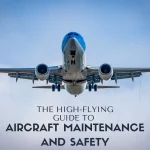Whether you’re a commercial pilot navigating the bustling skyways, a hobbyist flying for sheer joy, or even an astronaut preparing for takeoff, one constant is non-negotiable – the utmost importance of aircraft maintenance and safety. Every flight, from a short hop to a transatlantic crossing, is a delicate dance between man, machine, and the vast expanse of the atmosphere
In this comprehensive guide, pilots of all levels will explore the intricate world of aircraft maintenance and safety, armed with best practices and the latest technologies in aviation upkeep.
Mastering the Art of Aircraft Maintenance
Understanding aircraft maintenance begins with a deep dive into the craft’s anatomy. The airframe, akin to a bird’s skeletal structure, is the framework of the aircraft, and like bones, must withstand tremendous stress and forces. Then there’s the powerplant, the engine that breathes life into the vessel, propelling it through the air. Avionics, the nervous system that relays vital information, ensure that the aircraft operates within its limits.
The Airframe – More Than Skin Deep
The airframe is not just the aircraft’s outer shell; it encompasses every material, joint, and structure that keeps the plane whole. The integrity of the airframe is paramount to safety and is subject to rigorous inspections underpinning its condition. From composite materials to traditional aluminum, understanding these various materials is crucial, as is knowing when specialized maintenance is required.
The Pulse of the Powerplant
An aircraft’s powerplant is the source of its very ability to fly, making it an area of utmost importance. Regular inspections of the engine systems are imperative, from the spark plugs of a piston engine to the turbines of a jet. Additionally, pilots must constantly monitor engine health through performance data and visual inspections to ensure they are operating efficiently and safely.
Avionics – The Technological Surge
Modern aviation owes much to the leaps in avionic technology. These systems monitor the aircraft’s condition, guide its route, and enable communication with air traffic control. Regular checks and updates of these electronics are vital, and with the advent of digital cockpits, pilots must become adept at handling both traditional and cutting-edge avionics systems.
Pre-Flight Inspection – The Pilots’ Checklist
Before every takeoff, pilots meticulously go through a pre-flight inspection checklist. This physical and visual assessment serves to identify any issues that could jeopardize the flight, from worn-out tires to faulty avionics. The thoroughness of this process is not merely a recommendation; it’s a lifesaving routine that every pilot must undertake with precision and vigilance.
The Exterior Walk Around
Starting on the ground, the exterior inspection is a step-by-step evaluation of the aircraft’s external condition. Here, you’ll be looking for signs of damage, checking the fuel and oil levels, verifying that control surfaces are free and unobstructed, and ensuring the cowling is secure with no leaks.
The Interior Review
Beyond the cockpit door, the interior review involves verifying that the cabin and cargo areas are secure, assessing the visibility through windows, and ensuring that all necessary equipment is stowed safely and accessible. This is also the time to run through the cockpit checklist, including battery, avionics, and navigation system checks.
The Beacon of Regulation – Adhering to Manufacturer’s Maintenance
Aircraft manufacturers are not just makers of machines; they are keepers of safety standards. Their manuals and guidelines are beacons that pilots and maintenance crews must follow to the letter, covering everything from routine tasks to complex overhauls.
Scheduled Inspections
Routine inspections – A-through-D checks – are required at different intervals and become increasingly thorough. Understanding the purpose of these checks and what they entail provides a foundational understanding of your aircraft’s maintenance needs.
Lifespan of Components
Every component has a lifespan. Whether a spark plug needs replacement every hundred hours or high-strength fasteners need replacement after a set number of uses, understanding these timelines is critical. These timelines may vary based on the aircraft model, and pilots must be diligent in following the manufacturer’s guidelines.
In-Flight Maintenance and Safety Protocols
The real test of an aircraft’s upkeep is mid-flight. This is the time when the pilot expertise and the plane’s condition must seamlessly align to ensure a safe, efficient, and uneventful flight.
Continual Monitoring
Engines are operating under changing conditions throughout a flight. Continual monitoring means staying on top of adjustments, such as throttle settings, to keep the powerplant in its optimal performance range. Avionics must also be monitored, as they not only guide the flight but warns of any impending dangers.
Handling Emergencies
Even with meticulous maintenance, unexpected situations can arise. Pilots must be prepared to handle emergencies, from dealing with in-flight engine troubles to recognizing and addressing critical system malfunctions. Training and periodic simulations are essential to responding effectively to these high-stakes scenarios.
Advanced Technologies in Aircraft Maintenance
The world of aircraft maintenance is dynamic, with technology continually pushing boundaries. From high-strength fasteners designed to bear immense loads to advanced composite materials that enhance performance and longevity, these innovations are revolutionizing how aircraft are maintained.
Smart Sensors and Predictive Maintenance
Smart sensors are the eyes and ears keeping watch over your aircraft’s vital systems. Detecting irregularities before they become issues, these sensors allow for predictive maintenance – fixing problems before they result in costly downtime or safety risks.
Drones for Inspection
Drones are taking to the skies not just for recreation, but for the serious business of aircraft inspection. These unmanned aerial vehicles can access areas of the airframe that would be difficult or dangerous for human inspectors, providing high-resolution footage and data that allow for more detailed and efficient assessments.
In conclusion, the art of aircraft maintenance and safety is an ongoing commitment to precision, vigilance, and education. By understanding the essentials, committing to best practices, and staying abreast of technological advancements, pilots ensure the highest level of safety not just for themselves, but for all who share the skies.



